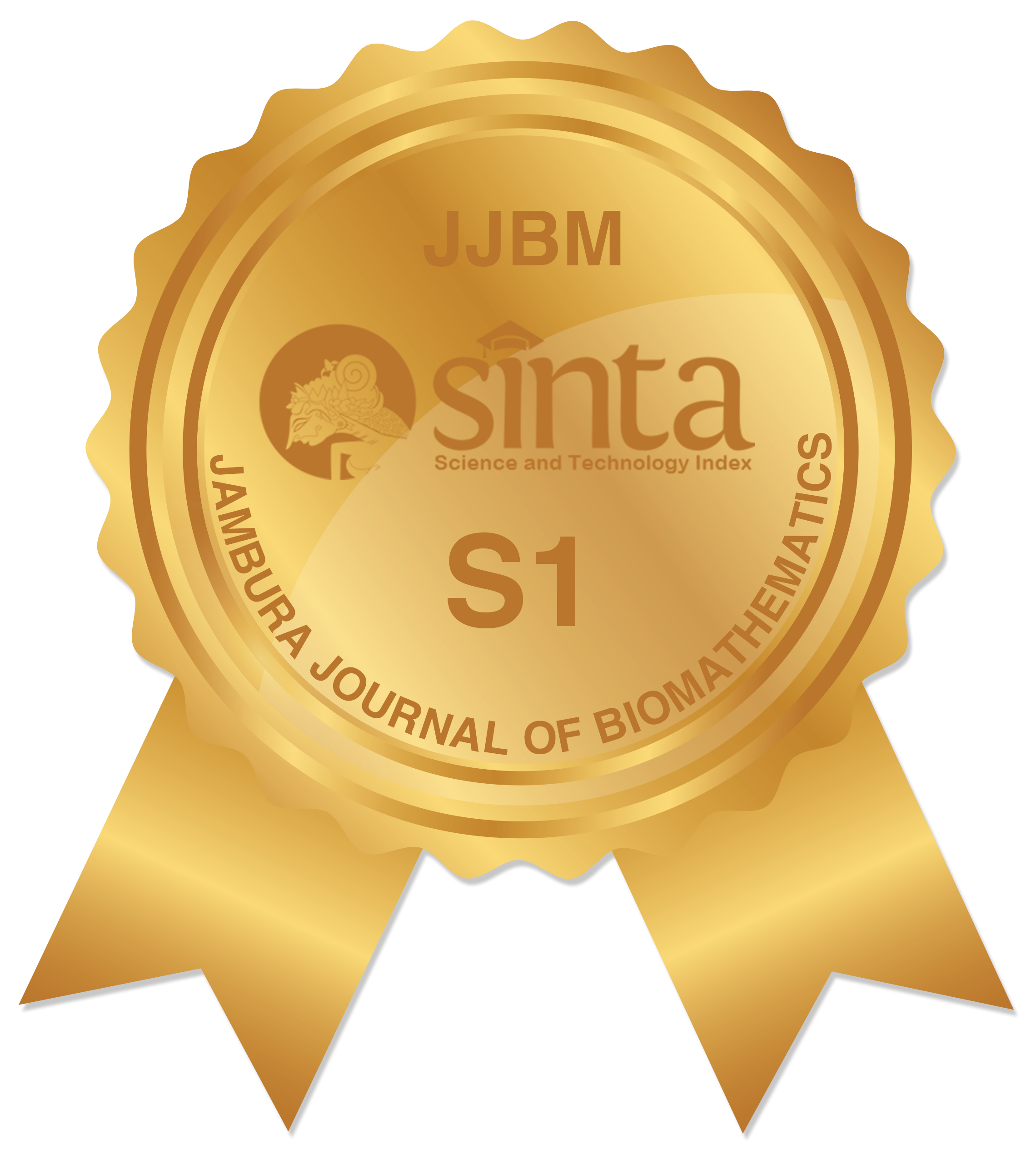A Qualitative Analysis of Leukemia Fractional Order SICW Model
Abstract
Using a series of fundamental differential equations, including the Caputo derivative, which makes it easier to specify the initial conditions of the differential equations, we present a fractional order concept of leukemia in this study. The universality, positivity, and boundedness of solutions are first established. The local stability properties of the equilibrium are studied using the fractional Routh-Hurwitz stability criteria. The differential equation system has been solved using unconventional finite difference techniques. The Leukemia Fractional Order SICW model introduces several innovative elements compared to traditional epidemiological and disease models. This stands out due to its integration of fractional-order differential equations, inclusion of leukemic cells and immune cells compartments, simulation of treatment strategies, consideration of waning immunity, and its application to leukemia-specific scenarios. These elements collectively make it a valuable tool for studying leukemia dynamics, exploring treatment options, and improving our understanding of how the immune system interacts with cancer cells in leukemia patients. Numerical simulations of the model are shown at the conclusion to interpret our theoretical outcomes in support of various fractional orders of derivative options. From there, we can observe how the evolution of the system components is impacted by the fractional derivative .
Keywords
Full Text:
PDFReferences
C. D. Mathers et al., "Cancer incidence, mortality and survival by site for 14 regions of the world," 2001, https://iris.who.int/handle/10665/67775.
M. A. Nowak and R. M. May, Virus Dynamics: Mathematical Principles of Immunology and Virology. Oxford University Press, 2000.
M. A.Nowak et al., "Viral dynamics in hepatitis B virus infection," Proceedings of the National Academy of Sciences of the United States of America, vol. 93, no. 9, pp. 4398-4402, 1996. DOI:10.1073/pnas.93.9.439
J. E.Wigginton and D. Kirschner, "A model to predict cell-mediated immune regulatory mechanisms during human infection with Mycobacterium tuberculosis," Journal of Immunology, vol. 166, no. 3, pp. 1951-1967, 2001. DOI:10.4049/jimmunol.166.3.1951
M. L. Olaosebikan, M. K.Kolawole, and K. A.Bashiru, "Transmission Dynamics of Tuberculosis Model with Control Strategies," Jambura Journal of Biomathematics (JJBM), vol. 4, no. 2, pp. 110-118, 2023. DOI:10.37905/jjbm.v4i2.21043
F. Nani and H. I. Freedman, "A mathematical model of cancer treatment by immunotherapy," Mathematical Biosciences, vol. 163, no. 2, pp. 159-199, 2000. DOI:10.1016/S0025-5564(99)00058-9
M. Kolev, "Mathematical modelling of the competition between tumors and immune system considering the role of the antibodies," Mathematical and Computer Modelling, vol. 37, no. 11, pp. 1143-1152, 2003. DOI:10.1016/S0895-7177(03)80018-3
S. I. Rubinow and J. L. Lebowitz, "A mathematical model of neutrophil production and control in normal man," Journal of Mathematical Biology, vol. 1, no. 3, pp. 187-225, 1975. DOI:10.1007/BF01273744
E. P. Cronkite and P. C.Vincent, "Granulocytopoiesis," Serum Haematology, vol. 2, pp. 3-43, 1969.
S. I. Rubinow, "A simple model of steady state differentiating cell system," Journal of Cell Biology, vol. 43, no. 1, pp. 32-39, 1969. DOI:10.1083/jcb.43.1.32
M. Agarwal and A. S. Bhadauria, "Mathematical Modeling and Analysis of Leukemia: Effect of External Engineered T Cells Infusion," An International Journal (AAM), vol. 10, no. 1, pp. 249-266, 2015.
H. Panigoro and E. Rahmi, "Computational dynamics of a Lotka-Volterra Model with additive Allee effect based on Atangana-Baleanu fractional derivative," ambura Journal of Biomathematics (JJBM), vol. 2, no. 2, pp. 96-103, 2021. DOI:10.34312/jjbm.v2i2.11886
A. Atangana, "Non validity of index law in fractional calculus: A fractional differential operator with Markovian and non-Markovian properties", Physica A: Statistical Mechanics and its Applications, vol. 505, pp. 688-706, 2018. DOI:10.1016/j.physa.2018.03.056
A. Atangana, Fractional Operators with Constant and Variable Order with Application to Geo-hydrology. Academic Press, New York, 2017. ISBN 9780128097960
A. Atangana and D. Baleanu, "New fractional derivatives with nonlocal and non-singular kernel: Theory and application to heat transfer model," Thermal Science, vol. 20, no. 2, pp. 763-769, 2016. DOI:10.2298/TSCI160111018A
I. Podlubny, Fractional Differential Equations. Academic Press, San Diego, 1999.
D. A. Benson, M. M. Meerschaert, and J. Revielle, "Fractional calculus in hydrologic modeling: A numerical perspective," Advances in Water Resources, vol. 51, pp. 479-497, 2013. DOI:10.1016/j.advwatres.2012.04.005
R. E. Mickens, Nonstandard Finite Difference Models of Differential Equations. World Scientific, Singapore, 2005. DOI:doi.org/10.1142/2081 [19] A. E. M. El-Misiery and E. Ahmed, "On a fractional model for earthquakes," Applied Mathematics and Computation, vol. 178, no. 2. pp.
-211, 2006. DOI:10.1016/j.amc.2005.10.011
E. Pindza and K. M.Owolabi, "Fourier spectral method for higher order space fractional reaction-diffusion equations," Communications in Nonlinear Science and Numerical Simulation, vol. 40, pp. 112-128, 2016. DOI:10.1016/j.cnsns.2016.04.020
F. C. Meral, T. J. Royston, and R. Magin, "Fractional calculus in viscoelasticity: An experimental study," Communications in Nonlinear Science and Numerical Simulation, vol. 15, no. 4, pp. 939-945, 2010. DOI:10.1016/j.cnsns.2009.05.004
M. P. Aghababa and M. Borjkhani, "Chaotic fractional-order model for muscular blood vessel and its control via fractional control scheme," Complexity, vol. 20, vol. 2, pp. 37-46, 2014. DOI:10.1002/cplx.21502
K. M. Owolabi, "Computational study of noninteger order system of predation," Chaos, vol. 29, no. 1, pp. 013120, 2019. DOI:10.1063/1.5079616
K. M. Owolabi and A. Atangana, "On the formulation of Adams-Bashforth scheme with Atangana-Baleanu-Caputo fractional derivative to model chaotic problems," Chaos, vol. 29, no. 2, pp. 023111, 2019. DOI:10.1063/1.5085490
K. M. Owolabi and Z. Hammouch, "Mathematical modeling and analysis of two-variable system with noninteger-order derivative," Chaos, vol. 29, no. , pp. 013145, 2019. DOI:10.1063/1.5086909
L. Debnath, "Recent applications of fractional calculus to science and engineering," International Journal of Mathematics and Mathematical Sciences, vol. 2003, no. 54, pp. 3413-3442, 2003. DOI:10.1155/S0161171203301486
F. A.Rihan, "Numerical modeling of fractional-order biological systems," Abstract and Applied Analysis, vol. 2013, no. 1, 2013. DOI:10.1155/2013/816803
H. Xu, "Analytical approximations for a population growth model with fractional order," Communications in Nonlinear Science and Numerical Simulation, vol. 14, no. 5, pp. 1978-1983, 2009. DOI:10.1016/j.cnsns.2008.07.006
Z. M. Odibat and N. T. Shawagfeh, "Generalized Taylor's formula," Applied Mathematics and Computation, vol. 186, no. 1, pp. 286-293, 2007. DOI:10.1016/j.amc.2006.07.102
A. Atangana, Derivative with a new parameter: Theory, methods and applications. Academic Press, 2015. ISBN 9780128038253
W. Lin, "Global existence theory and chaos control of fractional differential equations," Journal of Mathematical Analysis and Applications, vol. 332, no. 1, pp. 709-726, 2007. DOI:10.1016/j.jmaa.2006.10.040
E. Ahmed, A. M. A. El-Sayed, and H. A. A. El-Saka, "On some Routh-Hurwitz conditions for fractional order differential equations and their applications in Lorenz, Rössler, Chua and Chen systems," Physics Letters A, vol. 358, no. 1, pp. 1-4, 2006. DOI:10.1016/j.physleta.2006.04.087
K. M. Owolabi and K. C. Patidar, "Numerical simulations of multicomponent ecological models with adaptive methods," Theoretical Biology and Medical Modelling, vol. 13, no. 1, pp. 1, 2016. DOI:10.1186/s12976-016-0027-4
R. Anguelov and J. M. S. Lubuma, "Nonstandard finite difference method by nonlocal approximation," Mathematics and Computers in Simulation, vol. 61, no. 3-6, pp. 465-475, 2003. DOI:10.1016/S0378-4754(02)00106-4
L. Jódar et al., "Nonstandard numerical methods for a mathematical model for influenza disease," Mathematics and Computers in Simulation, vol. 79, no. 3, pp. 622-633. DOI:10.1016/j.matcom.2008.04.008
DOI: https://doi.org/10.37905/jjbm.v5i1.24961
Copyright (c) 2024 Kalyan Das, G. Ranjith Kumar, K. Ramesh, Md. Haider Ali Biswas

This work is licensed under a Creative Commons Attribution-NonCommercial 4.0 International License.
Jambura Journal of Biomathematics (JJBM) has been indexed by:
EDITORIAL OFFICE OF JAMBURA JOURNAL OF BIOMATHEMATICS |
 | Department of Mathematics, Faculty of Mathematics and Natural Science, Universitas Negeri Gorontalo Jl. Prof. Dr. Ing. B. J. Habibie, Moutong, Tilongkabila, Kabupaten Bone Bolango 96554, Gorontalo, Indonesia |
 | Email: [email protected] |
 | +6281356190818 (WA Only) |
 | Jambura Journal of Biomathematics (JJBM) by Department of Mathematics Universitas Negeri Gorontalo is licensed under a Creative Commons Attribution-NonCommercial 4.0 International License. Powered by Public Knowledge Project OJS. |















